 From Wikipedia:
From Wikipedia:
“In science, the term observer effect refers to changes that the act of observation will make on a phenomenon being observed.”
In plain English, this means that sometimes the act of looking at something changes it. While this is a technical term from physics, the idea has showed up in our lives the past two weeks.
First, the way we have observed the animals on this safari has had very little of the “observer effect”. They ignore the vehicles. We might as well not be here. The animals of Africa simply see the Toyota Land Runners as a benign beast that occasionally runs fast. They are so inured to the presence of these vehicles that cheetahs will occasionally jump on the hoods to get an elevated vantage point. In other words, these sleek cats see the truck as a large, tall rock.
Contrast this with a zoo or even Disney’s Animal Kingdom. We are fascinated with these animals, so we have constructed ways that we can observe them. But a lioness in an enclosure that cannot hunt is not the same lioness that we saw on the prowl or eating a kill.
The way we observe them in a zoo changes what they are.
The observer effect shows up a second time on this trip and this time we DO affect those being observed.
Some safaris companies arrange visits to tribes as well as treks through animal country. There are multiple indigenous tribes that live their lives as they did a century or a millenia ago, or at least they did until these visits began. We have visited 3 so far. They are (in decreasing order of modernization): the Maasai (famous warriors, herders and jumpers), the Datogo (herders and blacksmiths) and the Hadzabe (nomadic bush people who bowhunt).
Each visit was fascinating. Though we know that these visits are changing the tribes, we were surprised how much we connected to the people we spent time with. I would not have traded the experience for anything, but I fear that such visits will not be available to our grandchildren since each individual visit narrows the gap between our culture and theirs. [Note: I am not saying that these changes are all bad. In fact, as the tribes become more modern, they have improved health care, longer lifespans and reduced infant mortality. But they also lose some of their traditions and autonomy.]
I guess the challenge is to have visits that feel like visits and not like a cultural performance. If you have ever been to an “authentic Hawaiian luau”, you know what I mean: people in seats watching “native” people perform. In China we had a similar experience with the “long-haired tribe”. We bought tickets, boarded a bus and saw a performance of the women manipulating their marvelously long hair. After the show, we walked through the village as the women plied us with their wares as potential souvenirs.
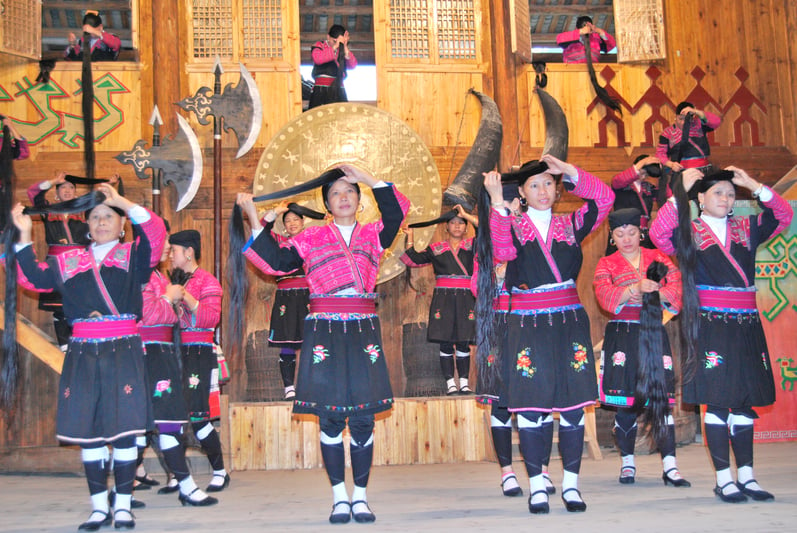
Was it interesting? Yes. Was it an authentic human interaction? No.
Our visits here were not yet like this, though each ended with an opportunity to buy crafts. But we thankfully enjoyed true side-by-side interaction with our hosts. We talked with them and even played with them. In one case, we joined them on a hunt (OK, perhaps “joined” is too strong a word. We walked and jogged behind them hoping not to spook any animals. I will blog about this tomorrow.)
This blog is about our trip to see the Maasai. The Maasai are the most populace and influential of the indigenous tribes. In fact, two men who grew up in Maasai villages have risen to become Tanzanian Prime Ministers, so they are that influential.
They have been displaced several times (like the US Native Americans), but have assimilated successfully into the country’s culture (like the New Zealand Maori).
They are famous for being fierce warriors. Killing a male lion was once the coming-of-age requirement, though thankfully no longer so. They are great herders. The “Maasai cattle” are very distinct. They are smaller and more durable than our meat cattle with large humps at their shoulders. The Maasai are forever walking around with their herds looking for water and grazing areas. They go out early and return to an enclosed village at night to protect their animals and themselves from night predators.
During the day, they are armed with long, strong sticks to “guide” cattle and deter nuisance animals. They also always have a machete.
They used to believe that all cattle are theirs by divine right, so they were excellent and enthusiastic cattle-raiders. To the relief of Tanzanians, they have abandoned this belief.
They wear a distinct clothe over a shoulder and the women have elaborate jewelry and beaded necklaces.
To our delight, our tour was not an arranged one. The tribe we had originally planned to meet had moved locations, so Walter found a new one that was less experienced with tour groups. I would like to think that this made them more authentic, but I am sure it made them friendlier.
It, however, started a bit like a luau.
The women and men lined up and began to sing/chant. Three women came up to Susie, Terrill and Virginia, put on some native ornamentation and took them by the hand to join them.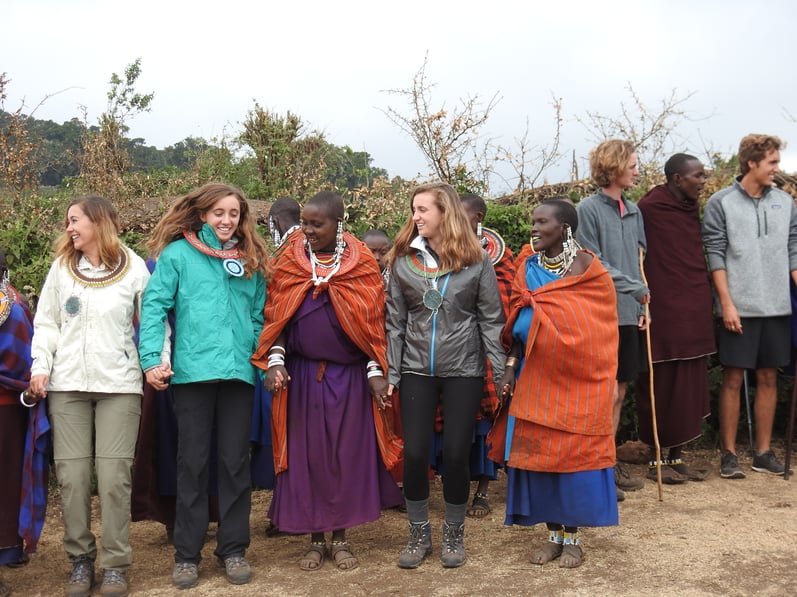
Meanwhile, the men cajoled the boys to join them as they did mild knee bends followed by spectacular vertical leaps (see the photo at the start of this blog). The Maasai are famous for these leaps and we could see why.
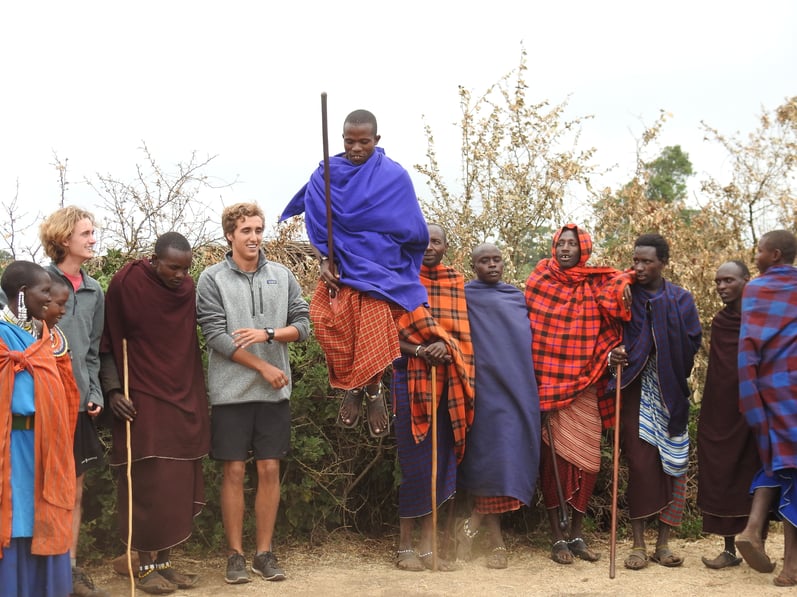
I was not asked to join. I would like to think that they recognized that I was the photographer, but I worry that they feared I would break a hip. Damn this grey hair!
After this initial participatory performance, we went inside their village and saw one of their huts and a demonstration of making fire using just sticks and tenders. So far, we were still “on a tour”.
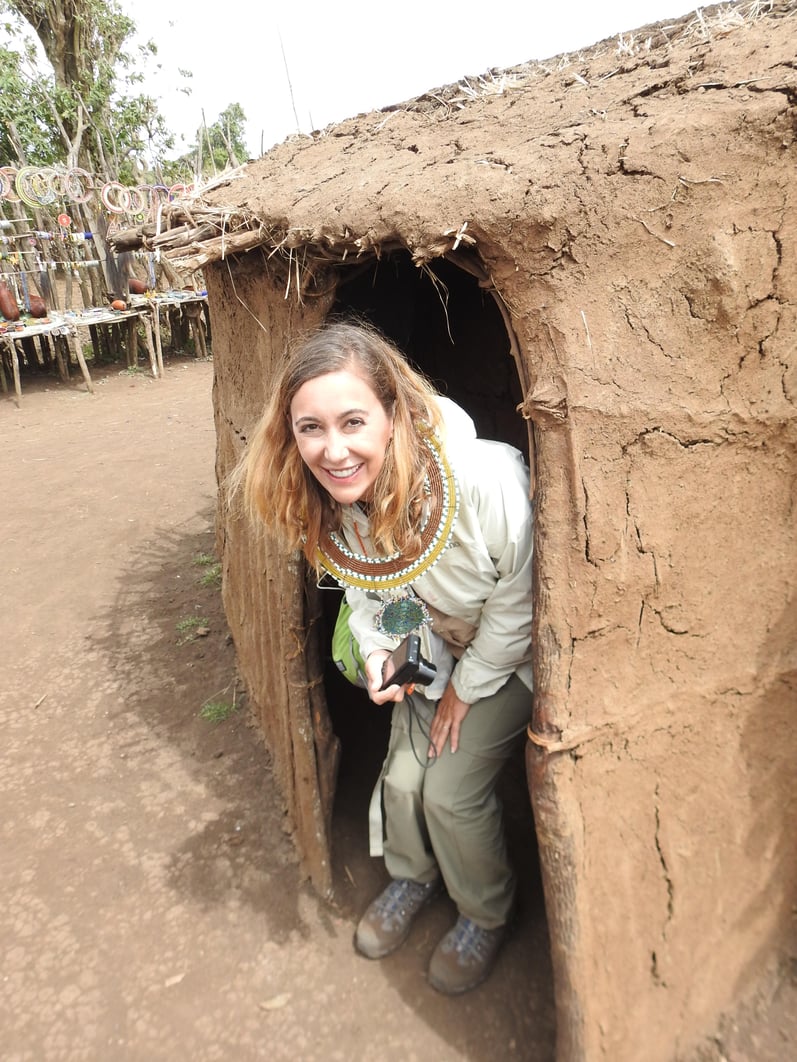
After these visits/demonstrations, we went outside to see their pre-school and kindergarten building. In this one room structure, the 60 or so children 7 and younger learned basic songs, the alphabet and counting. They sang for us in a well-practiced way.

It was at this point that the tour became an exchange. I asked Liam if he thought I could get the kids to do the Camp Champions “double thumbs up” sign.
“You want that to happen? I’m on it.”
He then stood at the head of the class and encouraged the students to do the pose. He then ran to the back of the room to join them in the picture.
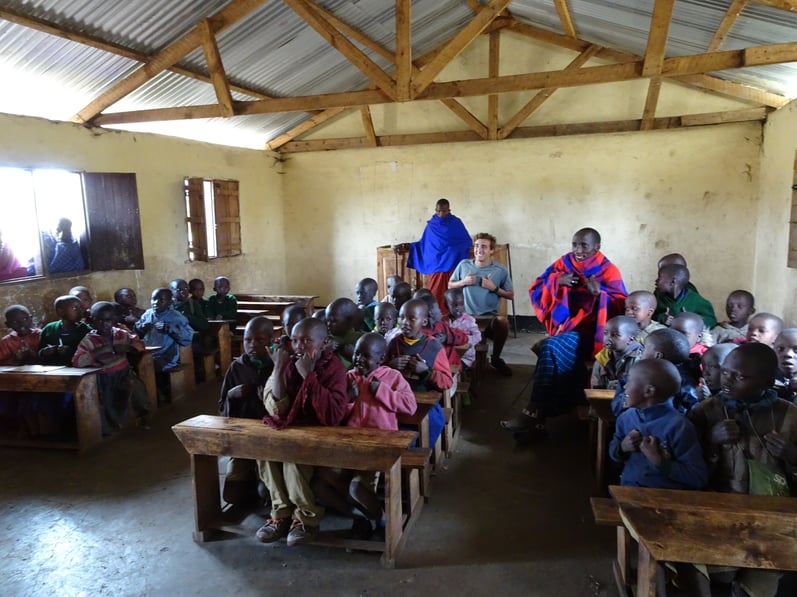
Clearly, we had just changed the ritual. Some of the children were delighted to smile and put up their thumbs, others were amused, still others were downright confused.
After the school-house, we went back to the village to look at the array of souvenirs. Within the center of the village, they had erected a large circular display structure for the crafts where the cattle would go later.
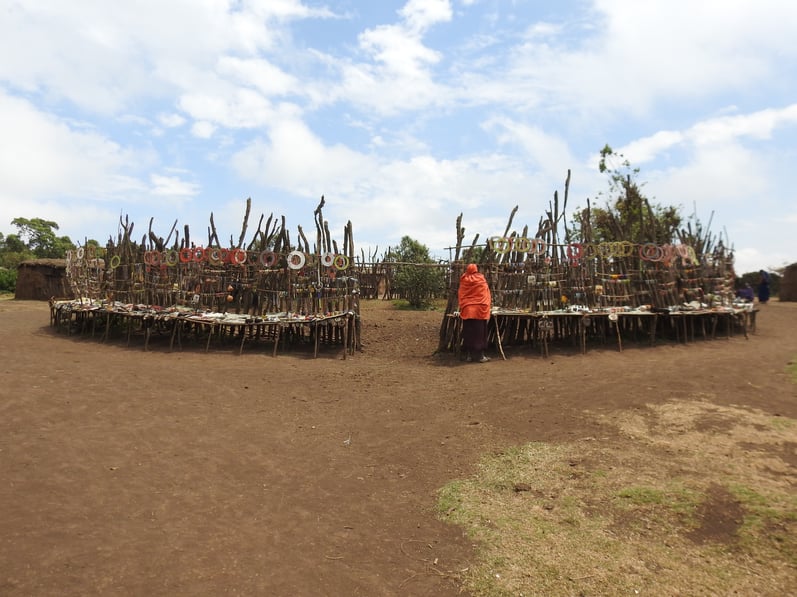
Meanwhile, I had a little surprise for the Maasai. As we showed you earlier, young boys awaiting their coming-of-age ceremony would spend time painted in black and white and essentially isolated from the rest of the tribe. We saw a few of them in the periphery. Their painting reminded me of our Trojan-Saprtan games, where the leaders “paint up” using elaborate designs that usually take 2 people an hour to do. This summer, Wiley (Spartans) and Liam (Trojans) were the 3rd term leaders.
I brought my iPad loaded with pictures of Liam and Wiley painted up.

I showed the photos to the leaders. They were initially deeply confused and later thoroughly delighted after Walter explained what they were seeing.
We then asked if we could show it to their three young initiates. I suspect that we were breaking protocol, but the leaders were clearly so thrilled with the photos that they called the young boys over. We showed them the pictures and asked them what they thought. They liked one of Liam’s three paint jobs best, but thought one of Wiley’s was the most frightening.

After this manly exchange, we started to head back into the village to rejoin Susie, Terrill and Virginia.
Liam then noticed that the children who had been in the classroom had ducked around the corner to play soccer. “I am down for that,” he declared and handed me his sweater. Wiley then joined in. I went inside to tell the girls, who then joined as well.
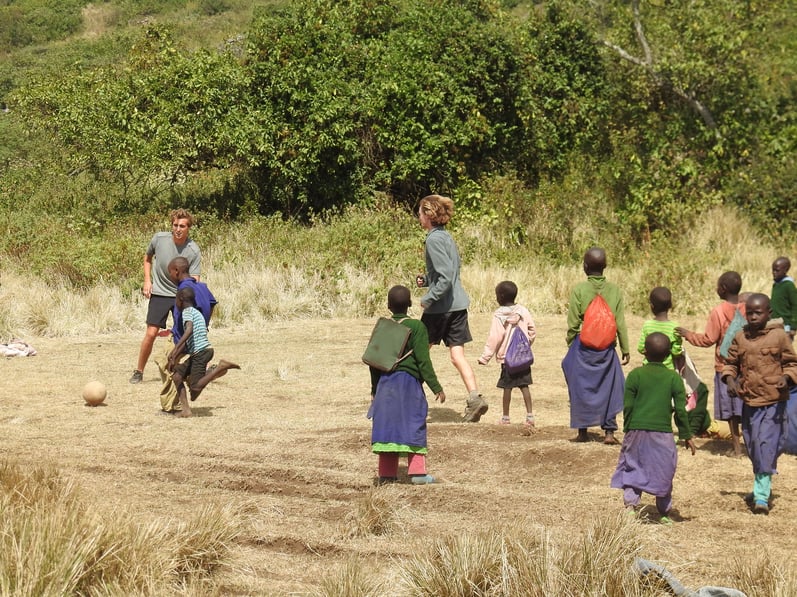
The play was notable for several reasons. The children were not keeping score, but they were playing hard. They were also incredibly tough. An accidental kick to the shin? No problem. A ball to the nose? Play on! There were no adults coaching or refereeing. It was just simple play.
I really liked that.
We concluded by making a meaningful contribution to their community in the form of purchases with tepid negotiations. We bought many necklaces, 10 chargers, several beaded animals, a Maasai ebony club and a beaded club. The leader started with an initial price and suggested an 8% drop because he “liked us”.
We generally do not like haggling. Liam loves it and was our super-weapon in China, but we did not want to unleash his skills on these less-wealthy people.
As Susie seemed ready to pay, the leader looked confused.
“Perhaps we should negotiate some more.”
I am not sure if he felt guilty at the price we were about to pay or if he simply liked to haggle. For whatever reason, we made a mild counter (down another 9%) and called it a day.
Susie and I think of it as 50% purchase and 50% contribution to a lovely community.
The women all then seemed very happy and gave us a series of gifts (perhaps to assuage their guilt from our overpaying). The leader beamed, “the women are so happy, you bought something from almost every woman in the tribe!” Of course, rather than delight us, it made us want to say “who did we leave out?” The habits of inclusion honed at camp continued in this village.
As we left, it was all hugs and handshakes with the adults. Meanwhile, our kids saw a group of their kids lying on the ground. Wiley had taught the children how to do a “high 5” and it was a huge hit. He and Virginia then high 5’ed their way through the children lying on the ground. Terrill gathered with a group of 10 or so and showed them some tricks with a hair rubber band. The kids loved playing with Terrill's and Virginia’s hair.


We then took this picture.

As we drove away, we felt like we had connected with many of these people despite massive differences. A smile, a good laugh and photos of sons painted up go a long way.
Steve Sir


